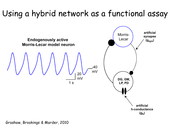Highlight
Understanding individual differences in brain function
Achievement/Results
Children and adults all know that all human beings are different and that all dogs and cats and other animals are also different from others of their species. Nonetheless, we have little understanding of how large the differences in the brains of a animals of a given species can be across the population of normal individuals. Moreover, for a variety of good reasons, most scientists choose to deal with variability in individual animals by calculating means, to treat the variability as “noise” rather than “signal”. Instead, the Marder laboratory at Brandeis University is now directly attempting to determine how variable the properties of single neurons, synapses, and circuits in different healthy animals can be. NSF-funded IGERT trainee, Rachel Grashow recently finished her PhD. For her thesis she used a computational technique, called the dynamic clamp to construct two neuron circuits. These hybrid circuits allowed her to do “simulations” with biological neurons, and to therefore adjust circuit parameters to understand how stable circuit behavior can arise from variable circuit components. Grashow is first author on two published papers describing this work.
Address Goals
This work addresses a very important problem that is usually ignored. Nonetheless, understanding the difference between health and disease and how animals will respond to environmental stress, requires understanding the extent to which individuals of the same species differ in their underlying brain structures and functions.






